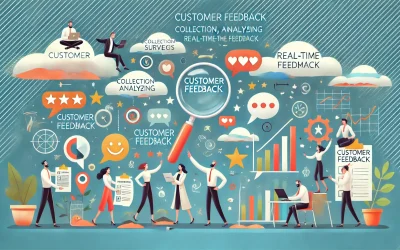Analyzing Customer Feedback for Actionable Insights
Collecting customer feedback is essential, but gathering this data is only the beginning. The true value of feedback lies in transforming it into actionable insights that can guide product decisions, refine user experience, and enhance customer satisfaction. Product teams need structured analysis methods to sift through raw feedback, uncovering patterns, themes, and trends that reveal what users truly need. In this post, we’ll explore three powerful feedback analysis techniques—thematic analysis, sentiment analysis, and frequency analysis—and how each method can unlock critical insights.
1. Thematic Analysis
Thematic analysis is a cornerstone method for processing qualitative data, enabling teams to identify patterns by grouping similar pieces of feedback into overarching themes. This approach provides a high-level view of customer sentiment, allowing teams to prioritize the areas that need attention.
How Thematic Analysis Works
In thematic analysis, feedback is reviewed and categorized based on recurring topics or issues. For example, if multiple customers mention difficulties with navigating the product, a “navigation pain points” theme can be created. Similarly, comments about confusing or missing instructions can be grouped under “user guidance issues.” This clustering of related feedback simplifies large volumes of data into key categories, making it easier to pinpoint common issues or needs.
According to the Harvard Business Review, thematic analysis “transforms large volumes of qualitative data into digestible insights by highlighting overarching themes.” This approach works particularly well with feedback from open-ended survey responses, customer interviews, and usability testing. With themes established, product teams can delve into each category to identify specific improvements that would have the greatest impact.
Tools for Thematic Analysis
- NVivo: A qualitative analysis software that organizes feedback data into themes, allowing teams to tag and search comments based on recurring topics.
- Dovetail: A user research platform that allows feedback to be tagged and categorized, helping to organize comments and responses into themes for easier analysis.
- Excel or Google Sheets: While not specialized, spreadsheets can be useful for smaller datasets by manually sorting feedback into themes, especially for teams with limited resources.
Benefits of Thematic Analysis
Thematic analysis distills qualitative data into understandable categories, helping teams see the broader picture without getting lost in individual comments. By identifying major themes, product teams can quickly determine which issues or features are most important to users. This approach ensures that feedback translates into focused improvements, addressing the areas that impact customer experience the most.
2. Sentiment Analysis
Sentiment analysis goes a step further by categorizing feedback based on the emotional tone expressed in customer comments. This type of analysis is ideal for tracking overall customer satisfaction, identifying pain points, and measuring how changes in the product affect user perception over time.
How Sentiment Analysis Works
Sentiment analysis uses natural language processing (NLP) and machine learning algorithms to categorize feedback into positive, negative, or neutral sentiment. By evaluating language, tone, and context, sentiment analysis can quantify how customers feel about a product or specific features. For example, phrases like “I love the new design” are flagged as positive, while “This feature is frustrating to use” would be marked as negative.
IBM research suggests that “sentiment analysis enables companies to improve product strategies by identifying common pain points that provoke negative responses.” By using sentiment analysis, teams can identify which features generate the most frustration and prioritize improvements accordingly. This approach is especially useful for products with frequent updates, as it allows teams to monitor shifts in sentiment following each release.
Tools for Sentiment Analysis
- MonkeyLearn: This tool offers NLP capabilities and can automatically categorize feedback based on sentiment, providing insights into customer emotions at scale.
- Lexalytics: Lexalytics specializes in sentiment analysis for customer feedback and provides detailed reports on the emotional tone of customer comments.
- HubSpot Service Hub: HubSpot’s sentiment analysis feature is built into its customer feedback module, making it easy to view positive and negative trends over time within the CRM.
Benefits of Sentiment Analysis
Sentiment analysis provides a quick snapshot of how customers feel about a product, which can be especially helpful when managing large volumes of feedback. By monitoring sentiment trends, product teams can detect spikes in negative feedback that may indicate issues with recent updates or features. This approach allows for proactive responses, helping companies address issues before they escalate and affect more customers.
3. Frequency Analysis
While thematic and sentiment analysis help categorize feedback, frequency analysis focuses on volume, identifying the most commonly mentioned issues or requests. This technique quantifies how often specific topics are raised, allowing teams to prioritize based on frequency.
How Frequency Analysis Works
In frequency analysis, keywords, phrases, or topics are tallied to determine which ones are mentioned most frequently. For instance, if customers frequently use terms like “too slow” or “hard to navigate,” it suggests that performance and ease of use are common pain points. By tracking these mentions, product teams can quickly see which areas are generating the most feedback, helping them prioritize high-impact improvements.
This method is particularly effective when analyzing survey data, usability tests, or support tickets, as it reveals patterns in what users find problematic or beneficial. In some cases, frequency analysis can highlight specific features or requests that may not have been on the team’s radar but are important to a significant portion of users.
Tools for Frequency Analysis
- Word Clouds: Tools like WordClouds.com or TagCrowd can create visual representations of frequently mentioned terms, making it easy to spot recurring themes at a glance.
- Excel Pivot Tables: Excel’s pivot tables can be used to count specific keywords or phrases, allowing teams to analyze frequency data even with basic tools.
- Qualtrics: This survey platform includes built-in frequency analysis tools for identifying common terms and phrases in survey responses, making it easy to track high-priority topics.
Benefits of Frequency Analysis
Frequency analysis offers a data-driven approach to prioritize feedback, allowing teams to focus on issues that impact the largest number of users. By concentrating on high-frequency feedback, companies can address the most pressing concerns, which often leads to improvements that benefit a wide user base.
Combining Analysis Methods for Deeper Insights
While each of these methods has its strengths, they are most effective when used together. For example, frequency analysis can highlight the most common issues, while thematic analysis provides context around those issues. Sentiment analysis adds an emotional layer, helping teams understand whether frequently mentioned topics generate frustration or delight.
For instance, if frequency analysis reveals that many users mention “product speed,” thematic analysis might break this down into “slow loading times” and “lag in navigation,” while sentiment analysis can indicate that these issues generate significant frustration. This combined approach provides a nuanced understanding, allowing teams to tackle high-priority areas with actionable steps.
Putting It All Together
Once insights are gathered, it’s essential to act on them. Prioritize issues based on their impact, align them with business goals, and incorporate them into the product roadmap. By using a structured approach to analyze customer feedback, companies can create a development process that is genuinely user-centered, leading to products that meet user needs and foster long-term loyalty.
Analyzing customer feedback with these methods provides a roadmap for improving customer satisfaction and product performance. With a structured approach, feedback becomes a powerful tool, helping teams make data-informed decisions that lead to impactful improvements.









